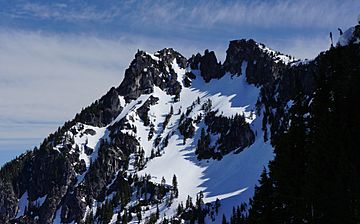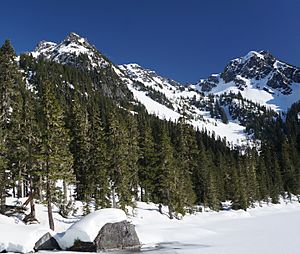Thunder Mountain (Washington) facts for kids
Quick facts for kids Thunder Mountain |
|
|---|---|

Southwest aspect from Surprise Gap
|
|
| Highest point | |
| Elevation | 6,556 ft (1,998 m) |
| Prominence | 276 ft (84 m) |
| Isolation | 0.55 mi (0.89 km) |
| Parent peak | Nimbus Mountain (6,711 ft) |
| Geography | |
| Location | King County / Chelan County Washington state, U.S. |
| Parent range | North Wenatchee Mountains Cascade Range |
| Topo map | USGS Scenic |
| Climbing | |
| Easiest route | Hiking West Ridge |
Thunder Mountain is a tall mountain in Washington state. It stands about 6,556-foot (1,998-metre) high. You can find it above the eastern shore of Glacier Lake. The mountain sits right on the border between King County and Chelan County.
Thunder Mountain is part of the Wenatchee Mountains, which are a smaller group within the larger Cascade Range. It's also located inside the Alpine Lakes Wilderness. This area is managed by the Mount Baker-Snoqualmie National Forest. Water from the mountain flows west into Surprise Creek or east into parts of Icicle Creek. The closest higher mountain is Nimbus Mountain, about 0.56 mi (0.90 km) to the northeast. Surprise Mountain is 0.88 mi (1.42 km) to the southwest. The famous Pacific Crest Trail passes near Thunder Mountain, between it and Spark Plug Mountain.
Weather at Thunder Mountain
Thunder Mountain is in a "marine west coast" climate zone. This means it gets a lot of weather from the Pacific Ocean. Most weather systems move northeast towards the Cascade Mountains.
When these weather systems hit the tall Cascade Mountains, they are forced to rise. As the air goes higher, it cools down and drops its moisture. This creates rain or snow on the mountains. This process is called Orographic lift. Because of this, the western side of the Cascades gets a lot of rain and snow, especially in winter.
In winter, it's often cloudy. But in summer, high-pressure systems over the Pacific Ocean often bring clear skies. Because the ocean influences the weather, the snow here can be wet and heavy. This can sometimes lead to avalanche danger. The best time to visit or climb Thunder Mountain is usually from July to September, when the weather is nicest.
How Thunder Mountain Was Formed
The Alpine Lakes Wilderness has very rugged land. You'll see jagged peaks, deep valleys carved by glaciers, and tall granite walls. There are also more than 700 mountain lakes!
These amazing landscapes and big changes in height were created by geological events over millions of years. These events also led to the different climates you find across the Cascade Range.
The Cascade Mountains started forming millions of years ago, during a time called the late Eocene Epoch. This happened because the North American Plate was slowly moving over the Pacific Plate. This movement caused a lot of volcanic activity. Also, small pieces of the Earth's crust, called terranes, helped build the North Cascades about 50 million years ago.
Later, during the Pleistocene period (which started over two million years ago), glaciers played a big role. Huge sheets of ice moved forward and backward many times. They scraped and shaped the land, creating the valleys we see today. The last glaciers in the Alpine Lakes area started melting about 14,000 years ago. They were gone from the Canada–US border by 10,000 years ago. The "U"-shaped valleys you see were carved by these glaciers.
The combination of the land pushing up (called uplift) and cracks in the Earth's crust (called faulting) along with the glaciers, created the tall peaks and deep valleys of the Alpine Lakes Wilderness.




